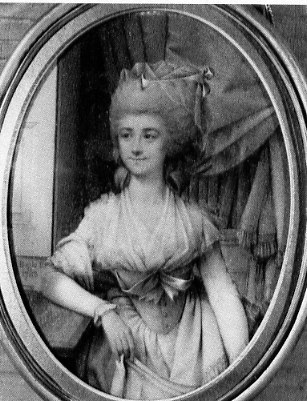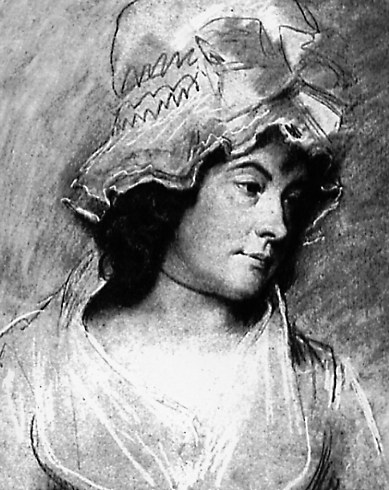
This essay first appeared in the Burney Letter, Vol ,6 No 2, (Fall 2000), p. 10.
By Ellen Moody

I first encountered Fanny Burney d'Arblay in a small plain 1940 Everyman edition of The Diary of Fanny Burney by Lewis Gibbs. I found it on a shelf in The Strand a vast second-hand bookstore in Manhattan. It was summer, sometime in the mid- 1960s. I cannot remember whether I found her under the "A's" or "B's" or "D's" of the "Literature" section, but I know I went with the intention of finding some Burney, as well as works about the French revolution. Since most readers nowadays first encounter Burney as the author of Evelina in college editions which announce author and text as important, my memories of an older time and different journey may be of interest.
Like Elaine Bander in whose footsteps I follow in filling this page of the Burney Letter, I was in my third year of college. I attended Queens College, a commuter school, but remember using the libraries of both Queens and Brooklyn College, two of the senior colleges of the City University of New York. Both libraries had a large collection of eighteenth- century books, and, as I recall, I could take home whatever I borrowed. I remark upon this because these collections included some very old books -- or at least so they seemed to me. What led me to seek Fanny Burney elsewhere was an edition of Ann Radcliffe's The Romance of the Forest in an exquisitely delicate three-volume set published sometime in the early nineteenth century. I am still fond of this novel of Radcliffe's out of regard for how it charmed me when I was young. It was Radcliffe who led to my looking for other writers of this period. I remember loving Charlotte Smith's The Old Manor House, gobbling up a very old Everyman called The Minor Poets of the Eighteeenth-Century, coming across a couple of Harriet Lee's Canterbury Tales, the first volume of Sophia Lee's The Recess, all of Robert Bage's Hermsprong, or Man as He Is Not, and reading various letters and memoirs translated from the French. There was the Princess de Lamballe who had been beheaded, and another book, a copy of which I now own, the Memoirs of Mlle. des »cherolles, an autobiography of a French gentlewoman who, with her family, was imprisoned during the Terror.
Unlike Elaine, I read Austen before Burney, and by this time knew all of the major novels but Emma. I had loved them, but I then thought of Austen as different, special, a genius. It was reading and enjoying other eighteenth-century writers, and especially women writers, which made me seek Burney. Was there no Burney, no Evelina on the shelves of these CUNY libraries? Maybe I kept turning up on days when all the Burney either library had on the open shelves had been taken out. I of course had read about her diaries because I also liked to read histories of literature. So I betook myself to The Strand to see what of Burney I could find there and lit upon Gibbs.
I was drawn to the Burney of Gibbs's book. I came away with vivid memories of the trauma of her years at court, and the grief she experienced when her husband and then her son both died before her. I much preferred the later sections, I admit, to those on Evelina and Streatham Park. I could not believe that Burney's friends and family members did not recognise Evelina as her work: their behavior was so pointed. The behaviour of everyone at Streatham was strained, and I felt sorry for Sophy Streatfield who cried upon their command. Still I wanted to read more, and a few years later (when I was richer) I made my way to a more selective and expensive Manhattan bookstore, the Argosy, and came away with a copy of an 1892 three-volume edition of Charlotte Barrett's The Diary and Letters of Madame d'Arblay (Frances Burney), notes by W. C. Ward, prefaced by Macaulay's essay. These are dark brown books which I still own. I enjoyed Macaulay, read avidly of Fanny's times at Bath, and much more of Cecilia, her years at court, her relationship with her husband, Camilla cottage, and the time in France too. I also bought James Clifford's life of Hester Lynch Thrale Piozzi; I had by then read much more by and of Johnson, so could bring to my reading perspectives and knowledge about "the Streatham set" which was lacking in the young Fanny Burney.
There is a value in coming to Fanny Burney not as the novelist hidden away behind the stage of her fiction, but as a diarist, letter-writer, and woman communing in her own private space with herself about the real events of her life, dramatising what she has experienced as it impinges directly on her. Burney makes her presence felt on the pages of her autobiographical writings; her phrases exude vibrant energies which are presented as fully alive. To the reader of her diaries and letters, she makes her mind's intensity immediately present. I have never wondered what originally inspired Joyce Hemlow to set out on her Herculean task, and write such a moving biography. I first read Evelina as part of a course assignment after I read my Charlotte Barrett volumes. I liked it much better than I otherwise would have, because I saw it as but one extension of Burney's mind, one whose limitations derive partly from the nature of the genre to which Evelina belongs.
There is also a value in not having to disengage Burney's writing from someone else's
framework. When I much more recently read Cecilia, Camilla, and
The Wanderer for the first time, they unfolded for me against what I have now read
of the McGill editions of Burney's diaries and letters, against the same kinds of writings by other
women in Burney's era, and against books by her contemporaries, French as well as English. I
do not compare them to Jane Austen nor place them in a history of the novel or old and new
feminisms. I can understand why her contemporaries fully expected The Wanderer
to take place in France; I was disappointed when I discovered that it did not.
I cannot say I retain the same half-grateful half-nostalgic emotion towards the Gibbs
Everyman that I do towards Radcliffe's The Romance of the Forest. For me that
emotion belongs to Barrett's volumes which have, by-the-bye, always been badly in need of
rebinding, testifying (I like to think) of how many times they were read before they came into my
hands. But Gibbs was my first gateway into the work of this remarkable writer.
The follow essays and book give the interested read significant information about the papers and editions of the works of Frances (Fanny) Burney d'Arblay -- as well as those of her husband, Alexandre d'Arblay.
